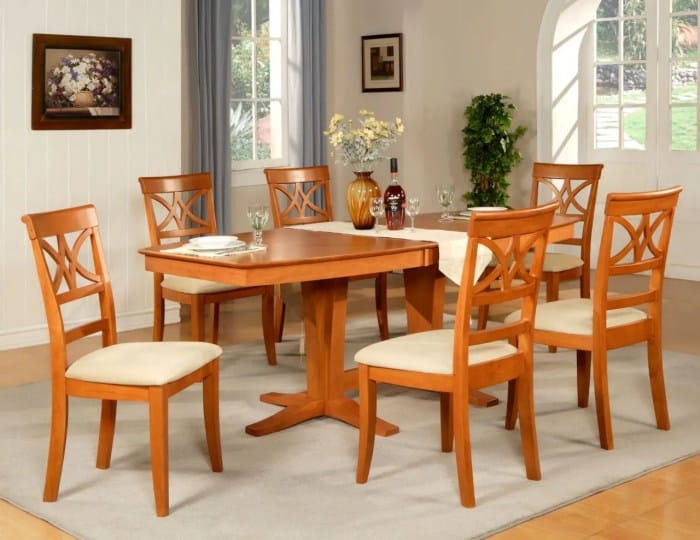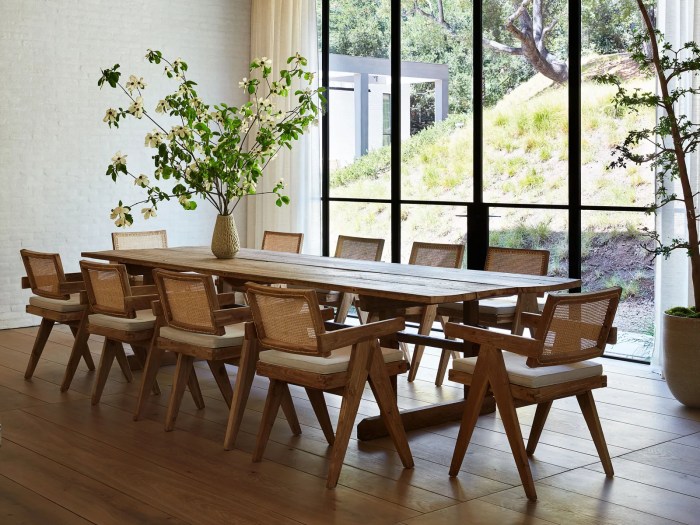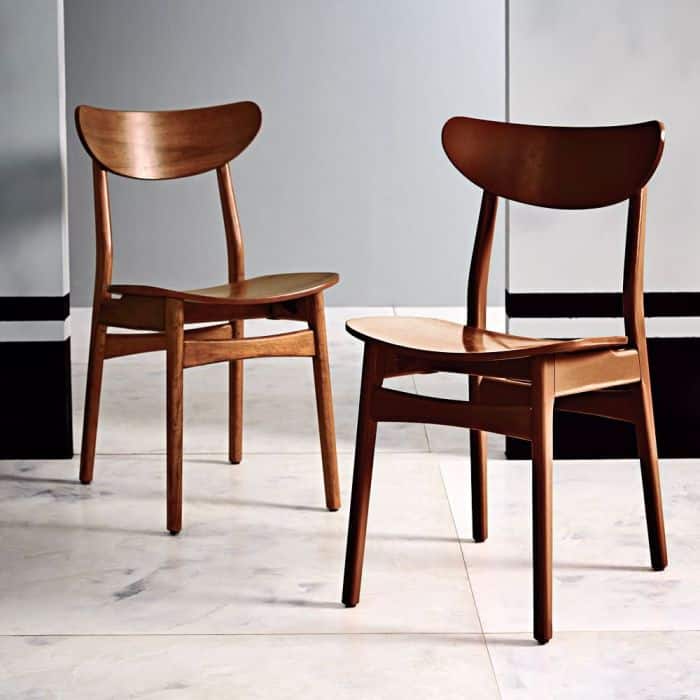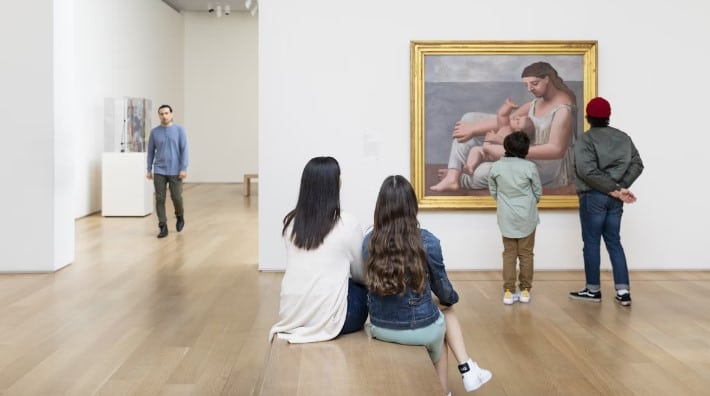globetraveo.com – Dining Chairs, the unsung heroes of our dining experiences, are more than just seats; they are statements of style, comfort, and functionality.
From classic elegance to modern minimalism, the world of dining chairs offers a vast array of options to complement every dining space and personal taste.
This guide will delve into the fascinating world of dining chairs, exploring their diverse styles, materials, features, and considerations for choosing the perfect chairs for your home.
Whether you’re seeking a timeless aesthetic, durable construction, or a chair that seamlessly blends with your existing décor, this exploration will provide valuable insights to help you navigate the world of dining chairs with confidence.
Dining Chair Styles
Dining chairs are an essential part of any dining room, and their style can significantly impact the overall aesthetic of the space. From classic to modern, farmhouse to industrial, there’s a dining chair style to suit every taste and decor.
Classic Dining Chair Styles, Dining Chairs
Classic dining chair styles are timeless and elegant, often characterized by their simple yet sophisticated designs. These chairs are known for their durability and versatility, making them suitable for a wide range of dining room settings.
- Chippendale Chairs: Named after the renowned English furniture maker Thomas Chippendale, these chairs feature intricate carvings and elegant proportions. They are often made from mahogany and feature a distinctive “cabriole” leg design, which is curved and outward-facing.
- Queen Anne Chairs: Inspired by the Queen Anne era in England, these chairs are known for their graceful curves and delicate ornamentation. They typically feature a “saddle seat” with a gently sloping back and cabriole legs.
- Windsor Chairs: Originating in England, Windsor chairs are characterized by their simple yet sturdy construction. They are often made from wood, with a curved back and a “spindle” design, which features vertical wooden rods connecting the seat to the back.
Modern Dining Chair Styles
Modern dining chair styles embrace clean lines, minimalist designs, and contemporary materials. They often feature bold geometric shapes, sleek silhouettes, and innovative use of materials like metal, plastic, and acrylic.
- Mid-Century Modern Chairs: Inspired by the design movement of the mid-20th century, these chairs are known for their organic forms, comfortable seating, and use of materials like plywood and leather. Iconic examples include the Eames Lounge Chair and the Barcelona Chair.
- Scandinavian Chairs: Scandinavian design emphasizes functionality, simplicity, and natural materials. These chairs often feature light wood frames, comfortable upholstery, and a minimalist aesthetic.
- Contemporary Chairs: Contemporary dining chairs embrace modern trends and incorporate innovative materials and designs. They often feature bold colors, geometric shapes, and unconventional materials like acrylic and metal.
Farmhouse Dining Chair Styles
Farmhouse dining chair styles evoke a sense of rustic charm and warmth. They are often characterized by their simple, functional designs and use of natural materials like wood and metal.
- Rustic Wood Chairs: These chairs are often made from reclaimed wood or distressed wood, giving them a unique and characterful look. They may feature simple designs with a natural finish or be adorned with decorative elements like metal accents or leather straps.
- X-Back Chairs: X-back chairs are a popular choice for farmhouse dining rooms. They feature a distinctive “X” shape in the back, which provides both structural support and a rustic aesthetic. They are often made from wood with a natural finish.
- Ladder Back Chairs: Ladder back chairs are characterized by their vertical slats in the back, which resemble a ladder. They are often made from wood and can be painted or stained to complement the farmhouse style.
Industrial Dining Chair Styles
Industrial dining chair styles embrace a raw, edgy aesthetic. They are often characterized by their use of metal, reclaimed wood, and exposed materials.
- Metal Chairs: Industrial dining chairs often feature metal frames with a distressed or raw finish. They may be made from steel, iron, or aluminum, and often have a simple, utilitarian design.
- Tolix Chairs: Tolix chairs are a classic example of industrial design. They are made from galvanized steel with a simple, stackable design. They are known for their durability and versatility, and are often used in cafes and restaurants.
- Pipe Chairs: Pipe chairs are characterized by their use of industrial piping for the frame. They often feature a simple, minimalist design with a raw, unfinished look.
Eclectic Dining Chair Styles
Eclectic dining chair styles embrace a mix of different styles and influences. They are often characterized by their unique designs, unexpected combinations of materials, and playful use of color.
- Global Inspired Chairs: Eclectic dining chairs may draw inspiration from different cultures and regions around the world. They may feature intricate carvings, bold colors, or unique materials that reflect global influences.
- Vintage Chairs: Vintage dining chairs can add a touch of history and character to any dining room. They may be antique chairs that have been restored or repurposed, or they may be vintage-inspired designs with a modern twist.
- Statement Chairs: Statement chairs are designed to make a bold impression. They may feature unique shapes, unconventional materials, or vibrant colors that stand out from the rest of the dining set.
Dining Chair Materials

Dining chairs are an essential part of any dining room, and their material plays a significant role in their durability, comfort, aesthetics, and overall cost. Choosing the right material for your dining chairs depends on your individual needs and preferences, as each material offers unique advantages and disadvantages.
Wood
Wood is a popular choice for dining chairs due to its natural beauty, durability, and versatility. It comes in a wide range of colors, grains, and finishes, allowing for a variety of styles and designs.
Wood is a timeless choice for dining chairs, admired for its natural beauty, durability, and adaptability to various design styles.
With diverse grains, colors, and finishes, it can complement both traditional and modern interiors. Its strength ensures long-lasting furniture, while its warmth adds a cozy ambiance to any dining space.
- Strengths:
- Durable and long-lasting, especially hardwoods like oak, maple, and walnut.
- Offers a warm and natural aesthetic.
- Versatile and can be stained or painted to match any décor.
- Can be refinished to restore its appearance.
- Weaknesses:
- Can be susceptible to scratches and dents.
- More expensive than other materials, especially for high-quality hardwoods.
- Requires regular maintenance, such as polishing and oiling, to prevent drying and cracking.
Metal
Metal dining chairs offer a modern and sleek aesthetic, and they are often chosen for their durability and ease of maintenance. They come in various metals, including steel, aluminum, and iron, each with its own unique properties.
- Strengths:
- Strong and durable, able to withstand heavy use and weight.
- Easy to clean and maintain, often requiring only a simple wipe-down.
- Available in a variety of styles and finishes, from polished chrome to rustic iron.
- Can be lightweight, making them easy to move around.
- Weaknesses:
- Can be cold and uncomfortable to sit on, especially in colder climates.
- Prone to rusting, especially if exposed to moisture.
- Can be noisy, especially if the chairs are not properly padded.
Plastic
Plastic dining chairs are a budget-friendly option, known for their lightweight and easy-to-clean properties. They are often chosen for outdoor dining or for families with young children.
- Strengths:
- Affordable and readily available.
- Lightweight and easy to move around.
- Resistant to moisture and stains, making them suitable for outdoor use.
- Easy to clean, often requiring only a simple wipe-down.
- Weaknesses:
- Not as durable as wood or metal chairs.
- Can be uncomfortable to sit on for long periods.
- May not be as aesthetically pleasing as wood or metal chairs.
- Prone to fading and cracking in direct sunlight.
Upholstery
Upholstered dining chairs offer comfort and style, with a wide variety of fabrics and patterns to choose from. They are often used in formal dining rooms or for special occasions.
- Strengths:
- Provides comfort and support.
- Offers a wide range of styles and designs.
- Can be customized with different fabrics and patterns.
- Can add a touch of elegance to any dining room.
- Weaknesses:
- More expensive than other materials.
- Requires regular cleaning and maintenance.
- Can be susceptible to stains and spills.
- May not be suitable for outdoor use.
Comparison Table
| Material | Strengths | Weaknesses | Maintenance Requirements |
|---|---|---|---|
| Wood | Durable, natural beauty, versatile | Susceptible to scratches and dents, expensive, requires regular maintenance | Polishing, oiling, refinishing |
| Metal | Strong, easy to clean, modern aesthetic | Cold and uncomfortable, prone to rusting, can be noisy | Wipe-down with a damp cloth |
| Plastic | Affordable, lightweight, easy to clean | Not as durable, uncomfortable, may not be aesthetically pleasing | Wipe-down with a damp cloth |
| Upholstery | Comfortable, stylish, customizable | Expensive, requires regular cleaning, susceptible to stains | Regular cleaning and spot cleaning |
Dining Chair Features
Dining chairs are more than just furniture; they are crucial components of the dining experience, influencing comfort, functionality, and overall aesthetics. The features of a dining chair play a significant role in determining its suitability for different dining settings and individual preferences.
Seat Height
The seat height of a dining chair is a critical factor in ensuring comfortable posture and proper ergonomics. An ideal seat height allows for a natural and relaxed position at the table, with feet comfortably resting on the floor.
- Standard Seat Height: The standard seat height for dining chairs is around 18 inches (45 cm), but it can vary depending on the table height and the individual’s height.
- Adjustable Seat Height: Some dining chairs offer adjustable seat heights, providing flexibility to accommodate different table heights and personal preferences.
- Impact on Comfort: A chair with a seat height that is too high can lead to discomfort in the legs and back, while a chair with a seat height that is too low can strain the back and neck.
Back Height
The back height of a dining chair provides support for the back and can significantly impact comfort, especially during prolonged dining sessions.
- Back Support: A higher back provides more support for the back, particularly the lumbar region, which can help to reduce strain and fatigue.
- Backrest Shape: The shape of the backrest can also influence comfort. Curved or contoured backrests offer better support and can help to promote good posture.
- Impact on Posture: A chair with adequate back support can encourage proper posture and reduce the risk of back pain.
Armrests
Armrests offer additional support and comfort, especially for people who prefer to rest their arms while dining.
- Armrest Placement: The placement of armrests is crucial. They should be positioned at a height that allows the elbows to rest comfortably without feeling cramped.
- Armrest Padding: Armrests with adequate padding can enhance comfort and prevent pressure points.
- Impact on Comfort: Armrests can enhance comfort and provide a sense of relaxation, especially during long meals.
Swivel Functionality
Swivel functionality allows the chair to rotate, which can be beneficial in certain dining settings.
- Ease of Movement: Swivel chairs make it easier to move around the table without having to stand up, which can be helpful in crowded dining spaces.
- Improved Interaction: Swivel chairs can facilitate conversation and interaction with others at the table, as users can easily turn to face different people.
- Impact on Dining Experience: Swivel chairs can enhance the dining experience by providing greater flexibility and ease of movement.
Comparison of Dining Chair Features
| Feature | Benefits | Drawbacks |
|---|---|---|
| Seat Height | Comfortable posture, reduced strain on legs and back | May not be suitable for all table heights or individuals |
| Back Height | Back support, improved posture, reduced fatigue | May feel restrictive for some individuals |
| Armrests | Enhanced comfort, support for arms, relaxation | May interfere with movement or space under the table |
| Swivel Functionality | Ease of movement, improved interaction, flexibility | May not be necessary or desirable in all dining settings |
Dining Chair Selection Considerations: Dining Chairs
Choosing the right dining chairs is crucial for creating a comfortable and stylish dining space. Several factors influence your decision, and carefully considering each aspect will ensure you select chairs that meet your needs and enhance your dining experience.
Dining Room Size and Seating Capacity
The size of your dining room plays a significant role in determining the number and style of chairs you can accommodate. Measure the available space and consider the dimensions of your dining table.
- Small Dining Rooms: Opt for compact chairs with a slim profile to maximize space. Consider using chairs with a smaller footprint or stackable chairs for easy storage when not in use.
- Large Dining Rooms: You have more flexibility to choose larger chairs, such as armchairs or chairs with wider seats. Consider incorporating different chair styles to create visual interest and define distinct seating areas.
Additionally, consider the desired seating capacity for your dining table. Choose chairs that comfortably accommodate your family and guests, allowing ample space for everyone to move around comfortably.
Dining Chair Styles and Preferences
The style of your dining chairs should complement the overall aesthetic of your dining room and dining table.
- Modern Dining Rooms: Sleek, minimalist chairs with clean lines and geometric shapes are ideal. Materials like metal, glass, or acrylic can create a contemporary look.
- Traditional Dining Rooms: Classic styles like Windsor chairs, Chippendale chairs, or ladder-back chairs offer timeless elegance. Choose chairs with intricate carvings, upholstery, or traditional finishes.
- Rustic Dining Rooms: Consider chairs made from natural materials like wood, leather, or woven fabrics. Chairs with distressed finishes or reclaimed wood elements can enhance a rustic aesthetic.
Think about your personal preferences and choose chairs that reflect your style and taste.
Dining Chair Materials and Durability
The material of your dining chairs significantly impacts their durability, comfort, and overall aesthetic.
- Wood: A classic and versatile material offering a range of styles and finishes. Choose hardwood like oak, maple, or walnut for durability and resilience.
- Metal: Modern and stylish, metal chairs can be lightweight and durable. Consider stainless steel, iron, or aluminum for a contemporary look.
- Upholstery: Provides comfort and adds a touch of luxury. Choose fabrics like leather, velvet, or linen based on your preferences and the overall style of your dining room.
- Plastic: Affordable and easy to clean, plastic chairs are a practical choice for families with children. Look for high-quality plastic that is durable and resistant to fading.
Consider the level of wear and tear your chairs will experience and choose materials that can withstand daily use.
Dining Chair Features and Comfort
Beyond aesthetics, consider features that enhance comfort and functionality.
- Seat Height: Choose chairs with a seat height that allows for comfortable posture and legroom. The ideal seat height should be about 18 inches from the floor.
- Backrest: A comfortable backrest is essential for long dining sessions. Consider chairs with high backrests for added support or low backrests for a more casual look.
- Armrests: Armrests can enhance comfort, but they can also make it difficult to push the chair under the table. Consider your needs and space limitations.
- Padding: Adequate padding ensures a comfortable seating experience. Choose chairs with sufficient cushioning for prolonged dining.
Think about how you will use your dining chairs and select features that meet your specific needs.
Dining Chair Care and Maintenance

Proper care and maintenance are crucial for extending the lifespan of your dining chairs and preserving their beauty. Regular cleaning and occasional repairs can help prevent wear and tear, ensuring that your chairs remain functional and aesthetically pleasing for years to come.
Cleaning Dining Chairs
The cleaning methods for dining chairs vary depending on the material they are made of.
- Upholstered Chairs: Vacuum regularly to remove dust and debris. For stains, use a mild upholstery cleaner or a mixture of mild soap and water. Blot the stain gently, working from the outside in to avoid spreading it. Allow the fabric to air dry completely.
- Wooden Chairs: Dust wooden chairs regularly with a soft cloth. For deeper cleaning, use a wood cleaner and polish. Avoid using harsh chemicals or abrasive cleaners, as these can damage the finish.
- Metal Chairs: Wipe metal chairs with a damp cloth and mild soap. Dry them thoroughly to prevent rust. For stubborn stains, use a metal polish.
- Plastic Chairs: Clean plastic chairs with a damp cloth and mild soap. Avoid using harsh chemicals or abrasive cleaners.
Common Dining Chair Problems and Solutions
Dining chairs can experience various problems over time. Here are some common issues and their potential solutions:
- Loose Joints: Tighten loose joints with a screwdriver or wrench. If the joint is severely damaged, consider replacing it.
- Scratched Wood: Use a wood filler to repair minor scratches. For deeper scratches, consider sanding and refinishing the chair.
- Torn Upholstery: Repair minor tears with fabric glue or a sewing kit. For larger tears, consider reupholstering the chair.
- Worn Cushions: Replace worn cushions with new ones or have them reupholstered.
- Rusty Metal: Clean rust with a wire brush or sandpaper. Apply a rust-resistant coating to prevent further rusting.
Dining Chair Trends

The dining chair market is constantly evolving, driven by changing consumer preferences and emerging design trends. From sustainable materials to personalized customization options, contemporary dining chairs reflect a shift towards conscious and stylish living.
Sustainable Materials
Sustainable materials are gaining popularity in dining chair design as consumers become more environmentally conscious. The use of recycled plastics, reclaimed wood, and natural fibers like bamboo and rattan is becoming increasingly common. These materials offer a unique aesthetic while minimizing the environmental impact of furniture production.
- Recycled Plastics: Recycled plastic chairs are durable, weather-resistant, and often come in vibrant colors. Examples include chairs made from recycled plastic bottles or industrial waste.
- Reclaimed Wood: Reclaimed wood chairs offer a rustic charm and contribute to a more sustainable approach to furniture production. They often feature unique grain patterns and textures, adding character to any dining space.
- Bamboo: Bamboo is a rapidly renewable resource that is lightweight, strong, and naturally beautiful. Bamboo chairs are becoming increasingly popular for their sustainable and eco-friendly qualities.
- Rattan: Rattan is a natural vine that is durable, lightweight, and breathable. Rattan chairs are often woven into intricate designs, adding a touch of bohemian elegance to any dining room.
Minimalist Aesthetics
Minimalist dining chairs are characterized by clean lines, simple shapes, and a focus on functionality. They are often made from natural materials like wood or metal, and they feature a neutral color palette. This aesthetic creates a sense of calm and sophistication in the dining space.
- Clean Lines and Simple Shapes: Minimalist chairs avoid unnecessary embellishments and focus on streamlined designs. They often feature straight lines, geometric shapes, and a minimalist silhouette.
- Natural Materials: Minimalist chairs often utilize natural materials like wood or metal, which are both durable and aesthetically pleasing. They often feature a natural finish, allowing the beauty of the material to shine through.
- Neutral Color Palette: Minimalist chairs typically feature a neutral color palette, such as white, black, gray, or natural wood tones. These colors create a sense of calm and sophistication and allow the chairs to blend seamlessly with different décor styles.
Personalized Customization Options
Consumers are increasingly seeking dining chairs that reflect their individual style and preferences. This has led to a rise in personalized customization options, allowing customers to tailor their chairs to their specific needs and tastes.
- Fabric and Upholstery Choices: Many manufacturers offer a wide range of fabric and upholstery options, allowing customers to choose the perfect texture and color to complement their dining room décor.
- Customizable Dimensions: Some manufacturers offer customizable dimensions, allowing customers to select chairs that are the perfect height and width for their dining table and space.
- Unique Finishes: Customers can often choose from a variety of finishes, such as stains, paints, and coatings, to personalize their dining chairs and create a unique look.
Impact of Trends on the Dining Chair Market
The growing popularity of sustainable materials, minimalist aesthetics, and personalized customization options is significantly impacting the dining chair market. Manufacturers are responding to these trends by offering a wider range of eco-friendly options, minimalist designs, and customizable features.
- Increased Demand for Sustainable Options: Consumers are increasingly seeking dining chairs made from sustainable materials, driving demand for products made from recycled plastics, reclaimed wood, bamboo, and rattan.
- Growing Popularity of Minimalist Designs: Minimalist dining chairs are becoming increasingly popular, reflecting a shift towards clean lines, simple shapes, and a focus on functionality.
- Rise of Personalized Customization: The desire for personalized customization is driving manufacturers to offer a wider range of fabric, upholstery, and finish options, allowing customers to create dining chairs that perfectly reflect their individual style.
Emerging Trends in Dining Chair Design
| Trend | Key Features |
|---|---|
| Multifunctional Dining Chairs | Chairs that can be used for multiple purposes, such as dining, working, or relaxing. They may feature adjustable heights, swivel bases, or built-in storage. |
| Smart Dining Chairs | Chairs that incorporate technology, such as built-in charging stations, Bluetooth speakers, or sensors that adjust the chair’s position based on the user’s weight and posture. |
| Modular Dining Chairs | Chairs that can be easily assembled and reconfigured, allowing customers to create custom dining sets that fit their space and style. |
As you embark on your dining chair journey, remember that the perfect chair is not just about aesthetics but also about functionality, comfort, and durability. By considering the factors Artikeld in this guide, you can confidently choose dining chairs that enhance your dining experience and add a touch of elegance and personality to your home.
FAQ Resource
What are some popular dining chair styles?
Popular dining chair styles include classic, modern, farmhouse, industrial, and eclectic. Each style reflects a distinct design aesthetic and historical context, offering a wide range of options to suit various tastes and preferences.
How do I choose the right dining chair height?
The ideal dining chair height should allow for comfortable legroom and posture while seated at the table. A general guideline is to choose chairs that are 18-20 inches tall, ensuring that your knees are slightly bent when seated and your feet are comfortably on the floor.
What are some tips for maintaining dining chairs?
Regular cleaning and maintenance are essential for preserving the beauty and longevity of your dining chairs. For upholstery, vacuum regularly and spot-clean spills promptly. For wood chairs, dust regularly and use a furniture polish to protect the finish. Metal chairs can be wiped clean with a damp cloth, while plastic chairs can be cleaned with a mild detergent and water.




